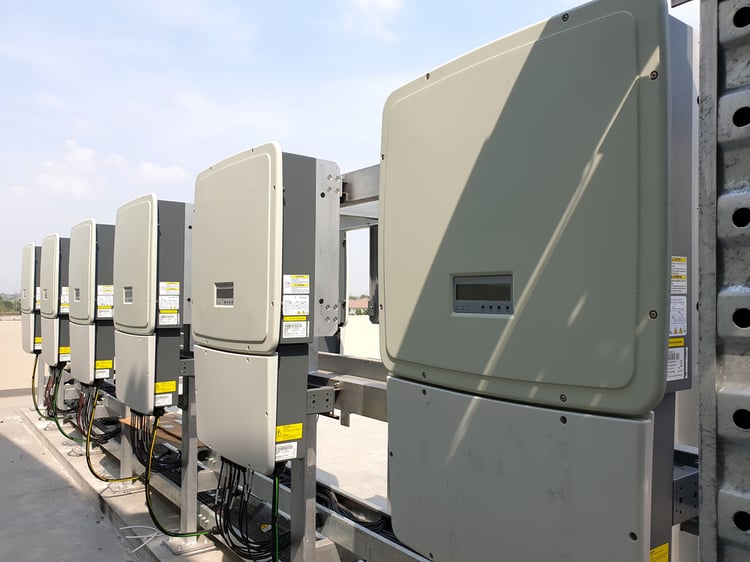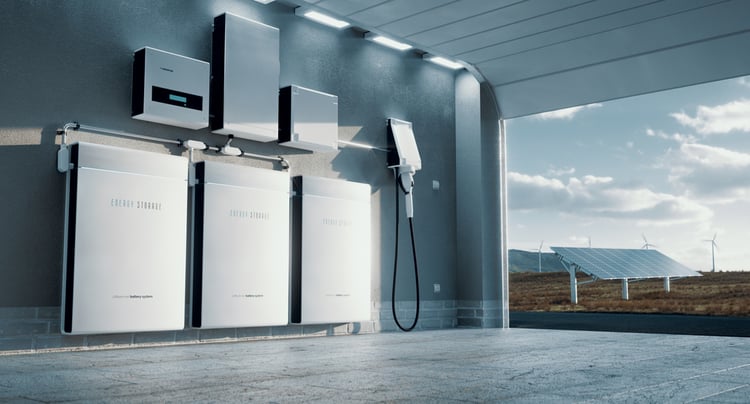AC-Coupled vs. DC-Coupled Solar Batteries: What Is the Difference?

Solar panels are much more useful when you combine them with an energy storage system. When used alone, they only generate power at maximum capacity for a few hours around noon. However, when you store the energy produced by solar panels in a battery of enough capacity, it can become a 24/7 power source.
A solar battery is especially useful when your electricity provider charges peak tariffs in the evening. You can simply fill up the battery with solar energy at noon, and then use that electricity at night to avoid the highest kilowatt-hour prices. If your electricity tariff includes demand charges, you can also use a battery to “trim” consumption peaks and reduce your bills.
Reduce your power bills and carbon footprint with solar panels and energy storage.
There are two main ways to connect battery systems with solar panels. You can have a DC-coupled system, where solar panels and batteries interact directly with DC power behind the inverter. On the other hand, an AC-coupled system uses separate inverters for your batteries and solar panels, and electricity travels between them as AC power. Like in any engineering decision, each option has pros and cons.
Keep in mind that all battery systems provide DC power: the difference lies in how they integrate with solar panels.
Overview of DC-Coupled Solar Batteries

Strong Point: Higher round-trip efficiency.
Weak Point: More complex installation, especially in existing solar PV systems.
In a DC-coupled system, batteries are connected to solar panels on the DC side of the inverter. This means electricity can be stored without an intermediate conversion to AC, and this makes the system more efficient. A DC-coupled battery of high quality can operate above 95% efficiency under optimal conditions, while AC batteries are limited to around 90% efficiency.
At first, DC-coupled batteries were more difficult to install. They required a dedicated charge controller to manage the electricity coming from solar panels, which would also connect to the inverter. However, there are now hybrid inverters where this function is built-in, and they can be connected with solar panels and batteries simultaneously.
The LG Chem RESU is among the best DC-coupled batteries in the market, and the largest version offers a storage capacity of 16 kWh. In addition, the LG Chem RESU is compatible with hybrid inverters from top brands like Fronius, Sungrow and SMA. The first version of the Tesla Powerwall was a DC battery, but it has been discontinued - the newer Powerwall 2 and Powerwall+ are both AC batteries.
When a new solar installation uses a hybrid inverter, adding a DC-coupled battery is very simple. However, these batteries cannot be added directly to existing PV systems with traditional inverters. In this case, you must upgrade the inverter to a compatible hybrid unit before installing the battery. You could also use a separate charge controller, but simply upgrading the inverter is a simpler solution in most cases.
Overview of AC-Coupled Solar Batteries

Strong Point: Simple installation, compatibility with existing solar PV systems.
Weak Point: Lower efficiency, since there are more power conversions involved.
AC-coupled batteries are much easier to install when you already have solar panels, since there is no need to modify the existing system. In this case, solar panels and batteries operate independently, and there is a separate inverter for each component. The Tesla Powerwall is the best-known battery that uses this design, with a storage capacity of 13.5 kWh.
The price to pay for the simpler installation of AC batteries is losing some efficiency. In a DC-coupled system, electricity from solar panels reaches the batteries without being converted to AC. On the other hand, there are two power conversions involved when charging AC batteries:
- DC power from solar panels is converted to AC power by the solar inverter.
- Electricity reaches the battery as AC power.
- The battery inverter converts electricity back into DC power to charge the battery.
- There is a final conversion from DC to AC when you use energy stored in the battery, but this also happens in DC-coupled systems.
Since there are two additional power conversions compared with a DC battery, more energy is lost in the process. However, this does not mean that AC-coupled batteries are inferior products: the inverters used in both systems have comparable efficiency, but there is only one power conversion when using DC-coupled systems. For example, three power conversions at 97% efficiency give you a total efficiency of 91%.
The main advantages of AC batteries are their simplicity and compatibility. Since there is no need to modify existing installations, they are much easier to install in buildings that already have solar panels.
Conclusion
You can use DC or AC batteries to add energy storage capacity to a solar panel system, and each option has strengths and limitations. DC batteries are superior in terms of energy efficiency, while AC batteries can be integrated more easily with existing solar arrays.
Both battery configurations can be used as backup power and off-grid systems, but you need an inverter that is designed for independent operation. Many inverters are only designed to integrate solar panels and batteries with your electrical installation, but not for backup power and off-grid systems.
Keep in mind that DC and AC batteries can be used together. For example, you can have a hybrid inverter connected to a DC battery, and also a separate AC battery.

Michael Tobias
Michael Tobias, the Founding Principal of NY Engineers, currently leads a team of 50+ MEP/FP engineers and has led over 1,000 projects in the US
Join 15,000+ Fellow Architects and Contractors
Get expert engineering tips straight to your inbox. Subscribe to the NY Engineers Blog below.



